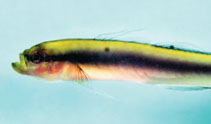| Family: |
Microdesmidae (Wormfishes), subfamily: Ptereleotrinae |
| Max. size: |
3.5 cm SL (male/unsexed) |
| Environment: |
benthopelagic; freshwater; brackish |
| Distribution: |
Western Indian Ocean: probably endemic of Seychelles, Mahé Island (Ref. 57749). |
| Diagnosis: |
Dorsal spines (total): 7-7; Dorsal soft rays (total): 16-17; Anal spines: 1-1; Anal soft rays: 17-18. Elongated body, slighthly laterally compressed. Dorsal and ventral profiles straight. Short snout. No teeth on vomer, nor on palatins. Superior jaw shows two raws of conical teeth. Vertical branchial opening, extending from superior insertion of the pectoral fin to its inferior insertion. Belly and prepelvic area with scales. Base of the pectoral without scales or only with a few ones. Pectorals pointed. Caudal is truncate for females and truncate to emarginate for males. Head and upper part of the body greenish-yellow, translucid and shiny. A wide lateral black stripe from the anterior edge of the eye, along the flanks to the posterior edge of the caudal peduncle. Black vertical mark on the caudal fin connected with the lateral stripe. Abdomen pinkish-white. Lower part of the cheek and operculum redish. Hyalin fins. Anal with black and white margins. Hyalin anal for females.Black and translucid for males (Ref. 57749). |
| Biology: |
Found in the lower part of rivers of Mahé Island, in tidal and freshwater area (Ref. 54851). Found in coastal area, mangrove and brackish waters but also in freshwaters in the lower part of the rivers close to the surface. Feed on zooplankton (Ref. 57749). |
| IUCN Red List Status: |
Not Evaluated (N.E.) Ref. (130435)
|
| Threat to humans: |
harmless |
Source and more info: www.fishbase.org. For personal, classroom, and other internal use only. Not for publication.

